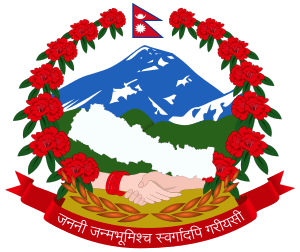Local self-government in Nepal
 |
|---|
| This article is part of a series on the politics and government of Nepal |
|
Executive:
Judiciary:
|
|
|
|
Related topics |
The Constitution of Nepal 2015 defines Nepal as a federal democratic republic organized around three levels of government – federal, state, and local.[1] Henceforth, state is divided into seven provinces and local is divided into 77 districts & 753 local levels (including six metropolises, 11 sub-metropolises, 276 municipalities and 460 gaunpalikas).[2][3][4] These 753 local units are known as the local level in Nepal. A total of 6,743 wards are formed under these 753 local levels. The Constitution of Nepal 2015 (Schedule 8) gives 22 powers to these local levels. This enables them to formulate laws to implement these powers. Besides these single powers, there are 15 such concurrent powers that can be implemented by all three level of state, i.e., federation, province, and local levels, in the principles of coordination, cooperation, and coexistence. [5]
See also
References
- ↑ "CIA – The World Factbook". Cia.gov. Retrieved 5 December 2012.
- ↑ "Nepal Provinces". statoids.com. Retrieved 2016-03-21.
- ↑ "753 new local units come into effect". The Kathmandu Post. Retrieved 2017-04-23.
- ↑ "Recently increased 22 local units published in Nepal Gazette". The Himalayan Times. Retrieved 26 May 2017.
- ↑ "Governance system in Nepal". Loksewa MCQ. Retrieved 5 June 2017.